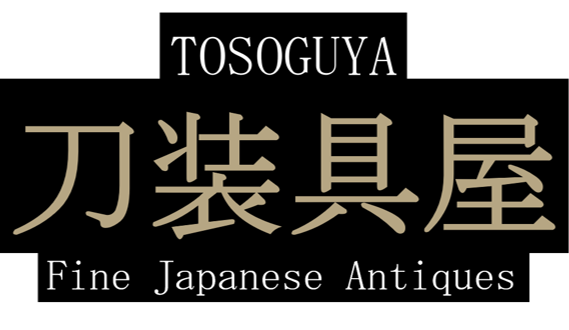

Fuchigashira (縁頭) by Ōoka Masatsugu (大岡政次), with mon motif of hi-ogi or cypress-fans (檜扇) and chanomi or teaberry (茶の実) mon of the Tachibana clan (橘氏) . The base metal is a shakudo alloy with nanako (赤銅魚子地), with gold application to rims and motif. Decorative motifs are neatly carved by a technique called takabori (高彫). This fuchi and kashira set is in outstanding condition, and represents Daimyō quality kinko work. It is balanced, sophisticated and dignified. The shakudo is of high gold content, giving it a lustrous black patina. The nanako is extremely uniform, with high, crisply defined nodes, in perfect rows (see detail inset). One of the highest quality nanako I have encountered in 30 years. If anyone is seeking a fine example of nanako, this set would be an unsurpassable addition to a collection.
Ōoka school is an offshoot of Hamano, with the first Ōoka master (Ōoka Masanobu) being the student of Hamano Shōzui. Of Shōzui's students, Masanobu's work was thought to rival that of his master, but with a more traditional, refined style. Ōoka Masatsugu was the third Ōoka master, lived in Edo, and was most active in the early decades of the 1800s. The Ōoka were retained by the Tokugawa daimyō of Owari, the senior-most branch of the Tokugawa family. Clearly Ōoka works attained the highest levels of craftsmanship, to be deserving of such patronage.
The Fuchi is signed: 大岡政次 (Ōoka Masatsugu) with a personal seal or kaō.
Joly: Shosankenshu, Reference 248
Haynes: Index of Japanese Sword Fittings and Associated Artists, Reference: 4720, School history: 4338, 4654
Saito: Sheet 329, #53
Wakayama Takeshi: Toso Kodogu Meiji Taikai, vol. 3 pg 187
Translation of the NBTHK Hozon paper description follows:
檜扇橘紋散図緑頭 (Hi-ogi Tachibana mon chi-zu fuchi-gashira)
銘 大岡政次 (花押) (Mei Ōoka Masatsugu
with kaō)
赤銅 魚子地 高彫 色絵 (Shakudō nanako-ji takabori
iroe)
Reiwa 4th year (2022) December 22nd
Measurements: Fuchi: 3.5cm x 1.8cm x 0.8cm Kashira: 3.9cm x 2.1cm x 1.0cm.
Late Edo Period (江戸時代)
SOLD

